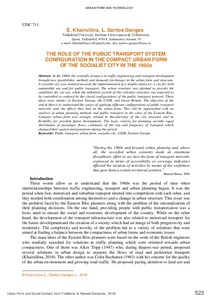THE ROLE OF THE PUBLIC TRANSPORT SYSTEM CONFIGURATION IN THE COMPACT URBAN FORM OF THE SOCIALIST CITY IN THE 1960s
Скачать файл:
URI (для ссылок/цитирований):
https://elib.sfu-kras.ru/handle/2311/111724Автор:
Khairullina, E
Santos, Ganges L.
(Khairullina, E., Santos, G. L.: Valladolid University, Instituto Universitario de Urbanística, Spain, Valladolid, 47014, Salamanca Avenue 18 e-mail: khairullina.es@gmail.com; luis.santos.ganges@uva.es)
Дата:
2019-05Proceedings of the XXV ISUF International Conference “Urban Form and Social Context: from Traditions to Newest Demands” (Krasnoyarsk, July 5–9, 2018)
Аннотация:
In the 1960s the scientific progress in traffic engineering and transport development brought new possibilities, methods and demands forchanges in the urban form and structure. A socialist city was oriented towards the implementation of a double objective: a city for both automobile use and for public transport. The urban structure was planned to provide the conditions for car use, while the unlimited growth of this reticular structure was expected to be controlled or ordered by the closed configurations of the public transport network. These ideas were similar in Eastern Europe, the USSR, and Great Britain. The objective of the article then is to understand the causes of applying different configurations of public transport networks and, the effects they had on the urban form. This will be approached with an analysis of urban planning methods and public transport in the cities of the Eastern Bloc. Compact urban form was strongly related to thecoherence of the city structure and its flexibility for possible future development. The basic criteria for planning werethe equal distribution of passenger flows, continuity of the trip and frequency of transport which changed their spatial interpretations during the period.

